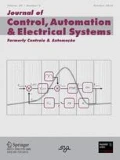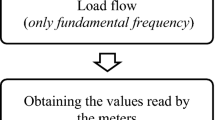Abstract
The increasing use of non-linear loads in industry makes relevant monitoring the levels of harmonic distortion in the electrical systems. However, even with the reduction of costs associated with the acquisition of power quality meters, installing them in all the buses of a distribution system is uneconomical. In this context, it is proposed in this article an algorithm based on evolutionary strategies, able to estimate the harmonic distortion and power flow, in fundamental frequency, of a distribution system monitoring only a few buses. The performance of the proposed algorithm will be evaluated in IEEE 5-bus and IEEE 14-bus systems.






Similar content being viewed by others
References
Amabis, J. M., & Martho, G. R. (1985). Curso básico de biologia (Basic course in biology) (Vol. 3). São Paulo: Editora Moderna Ltda.
Arrillaga, J., & Watson, N. R. (2003). Power system harmonics. New York: Wiley.
Back, T., Hammel, U., & Schwefel, H. P. (1997). Evolutionary computation: Comments on the history and current state. IEEE Transactions on Evolutionary Computation, 1, 3–17.
Back, T., & Schwefel, H.-P. (1996). Evolutionary computation: An overview. In Proceedings of IEEE International Conference on Evolutionary Computation, (pp. 20–29).
Ballard, D. H. (1997). An introduction to natural computation. Cambridge, MA: MIT Press.
De Jong, K. A. (2006). Evolutionary computation: A unified approach. Cambridge, MA: MIT Press.
Eiben, A. E., & Smith, J. E. (2003). Introduction to evolutionary computing. Berlin: Springer.
Heydt, G. T. (1989). Identification of harmonic sources by a state estimation technique. IEEE Transactions on Power Delivery, 4, 8.
IEEE 14-bus test system data. (1993). Retrieved February 1, 2013, http://www.ee.washington.edu/research/pstca/pf14/pg_tca14bus.htm.
Kagan, N., Arruda, E. F., & Ribeiro, P. F. (2010). Harmonic distortion state estimation using an evolutionary strategy. IEEE Transactions on Power Delivery, 25(2), 831–842.
Logenthiran, T., Srinivasan, D., Khambadkone, & A. M., Raj, T. S. (2010). Optimal sizing of an islanded microgrid using evolutionary strategy. In IEEE 11th International Conference on Probabilistic Methods Applied to Power Systems (PMAPS).
Mange, D., & Tomassini, M. (1998). Bio-inspired computing machines: Towards novel computational architectures. Lausanne: Presses Polytechniques et Universitaires Romandes.
Martinez, A., Vargas, H., & Perez, J. (2012). An evolutionary software engineering approach applied to a hybrid algorithm for face recognition. In Robotics Symposium and Latin American Robotics Symposium (SBR-LARS).
Ridley, M. (1996). Evolution (2nd ed.). Cambridge, MA: Blackwell Science.
Schwefel, H.-P. (1981). Numerical optimization of computer models. Chichester, NY: Wiley.
Stagg, G. W., & Abiad, A. H. El. (1968). Computer methods in power system analysis. New York: McGraw-Hill.
Zelingher, S., Fardanesh, B., Uzunovic, E., Meliopoulos, A. P. S., & Cokkinides, G. J. (2006). Harmonic monitoring system via GPS-synchronized measurements—update and new developments. In IEEE Power Engineering Society General Meeting.
Zhang, M., Yin, L., & Zhou, Y. (2010). Hybrid evolution strategies for simultaneous solving all real roots of polynomial. In International Conference on Computer, Mechatronics, Control and Electronic Engineering (CMCE).
Author information
Authors and Affiliations
Corresponding author
Appendix
Appendix
Tables 9, 10, 11, 12, 13 and 14 list the fundamental and harmonic voltage components values obtained from the power flow and harmonic state for the IEEE 5-bus and IEEE 14-bus systems through the PSCAD transient electromagnetic software, from the harmonic current injection in some buses chosen randomly.
Rights and permissions
About this article
Cite this article
do Nascimento Sepulchro, W., Encarnação, L.F. & Brunoro, M. Harmonic State and Power Flow Estimation in Distribution Systems Using Evolutionary Strategy. J Control Autom Electr Syst 25, 358–367 (2014). https://doi.org/10.1007/s40313-014-0110-1
Received:
Revised:
Accepted:
Published:
Issue Date:
DOI: https://doi.org/10.1007/s40313-014-0110-1




